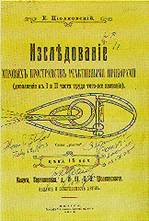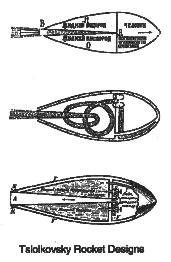Konstantin Eduardovitch Tsiolkovsky
Страница 2
This was the first drawing of Tsiolkovsky's of a space vehicle, from "Free Space" (1883). It shows cosmonauts in weightlessness, gyroscopes for attitude control, and an airlock for exit into free space.
· "The Tsiolkovsky Rocket Equation". He created his calculations about space flight theory on May 10, 1897. The first publication of the results was in the article "Exploration of the Universe with Reaction Machines", in the monthly magazine "The Science Review",# 5 (St.Petersburg, 1903). This was the first publication in the world on this subject.
 His Classic article "Research into Interplanetary Space by Means of Rocket Power" was published in 1903, the year of the first airplane flight by the Wright Brothers. It accurately described the state of weightlessness and the theoretical function of rockets in a vacume. He demonstrated why rockets would be needed for space exploration, and also advocated the use of liquid propellants that are used today.
His Classic article "Research into Interplanetary Space by Means of Rocket Power" was published in 1903, the year of the first airplane flight by the Wright Brothers. It accurately described the state of weightlessness and the theoretical function of rockets in a vacume. He demonstrated why rockets would be needed for space exploration, and also advocated the use of liquid propellants that are used today.
This is his book published in 1914 that was the reprint of the 1903 article.
·  "Plan of Space Exploration". This was published in 1926. It consists of 16 Points, from the very begining of space conquest, until the far distant future, including interstellar travel.
"Plan of Space Exploration". This was published in 1926. It consists of 16 Points, from the very begining of space conquest, until the far distant future, including interstellar travel.
He also wrote science fiction books, including "On The Moon (1895), Dreams of the Earth and Sky (1895), and Beyond the Earth (1920).
· "The Space Rocket Trains". (1929). This publication of Tsiolkovsky was about his original idea of a multi-stage rocket, which consisted of several separate rockets, one on top of another. Tsiolkovsky proved that only such a type of rocket would be able to reach escape velocity and fly to Earth orbit.
· "Album of Space Travels". (1932). The drawings from this manuscript of Tsiolkovsky show us his brilliant ideas about life in space, including zero gravity, air pressure locking, space habitats, rocket guidance, etc.
Tsiolkovsky's Cosmic Philosophy "All the Universe is full of the life of perfect creatures." Tsiolkovsky.
Tsiolkovsky was very much as interested in the philosophy of space as he was with the engineering needed to make space flight possible. This was the very begining of Tsiolkovsky's research into space flight problems and was the basis for it. His main work of this subject was "Ethics or the Natural Foundations of Morality" (1902-1918). In 1932 Tsiolkovsky wrote "The Cosmic Philosophy" - the summary of his philosophical ideas. His main idea was to achieve happiness not only for humanity, but also for all the living beings in the Cosmos, for all the Universe. He believed that human occupation of space was inevitable and would drive human evolution.
According to Tsiolkovsky's Cosmic Philosophy, "happiness" is the absence of all kind of suffering in all the Universe, for all times, as well as the absence of all of the processes for destroying goodness. How shall we start this evolution to the "Universial Happiness"? The main task is to study the laws which rule the Universe. To do so, we must study the Universe, and therefore we must learn how to live in outer space. To begin that long period of our evolution, we will have to design large manned space rockets. So, the first space flight will be the beginning of the new era of space exploration, the beginning of Space Culture in human history. It will be the beginning of our history itself. He truly beleived that it was the destiny of humankind to occupy the solar system and then to expand into the depth of the cosmos, living off the energy of the stars to create a cosmic civilization that would master nature, abolish natural catastrophes, and acheive happiness for all.
1n 1926 Tsiolkovsky defined his "Plan of Space Exploration", consisting of sixteen steps for human expansion into space:
1) Creation of rocket airplanes with wings.
2) Progressively increasing the speed and altitude of these airplanes.
3) Production of real rockets-without wings.
4) Ability to land on the surface of the sea.
5) Reaching excape velocity (about 8 Km/second), and the first flight into Earth orbit.
6) Lengthening rocket flight times in space.
7) Experimental use of plants to make an artificial atmosphere in spacships.
8) Using pressurized space suits for activity outside of spaceships.
9) Making orbiting greenhouses for plants.
10) Constructing large orbital habitats around the Earth.
11) Using solar radiation to grow food, to heat space quarters, and for transport throughout the Solar System.
12) Colonization of the asteroid belt.
13) Colonization of the entire Solar System and beyond.
14) Acheivement of individual and social perfection.
15) Overcrowding of the Solar System and the colonization of the Milky Way (the Galaxy).
16) The Sun begins to die and the people remaining in the Solar System's population go to other suns.

Kosmodemyanksy, Arkady A., 1956. Konstantin Tsiolkovsky: His Life and Works. Foreign Languages Publishing House, Moscow, Russia.
Shkolenko, Yuri, 1987. The Space Age. Progress, Moscow.
Samiolovitch, Sergei, I., 1969. Citizen of the Universe: Sketches of the Life and Works of Konstantin Eduardovitch Tsiolkovsky (in Russian). Tsiolkovsiy State Museum of the History of Cosmonautics, Kaluga, Russia.